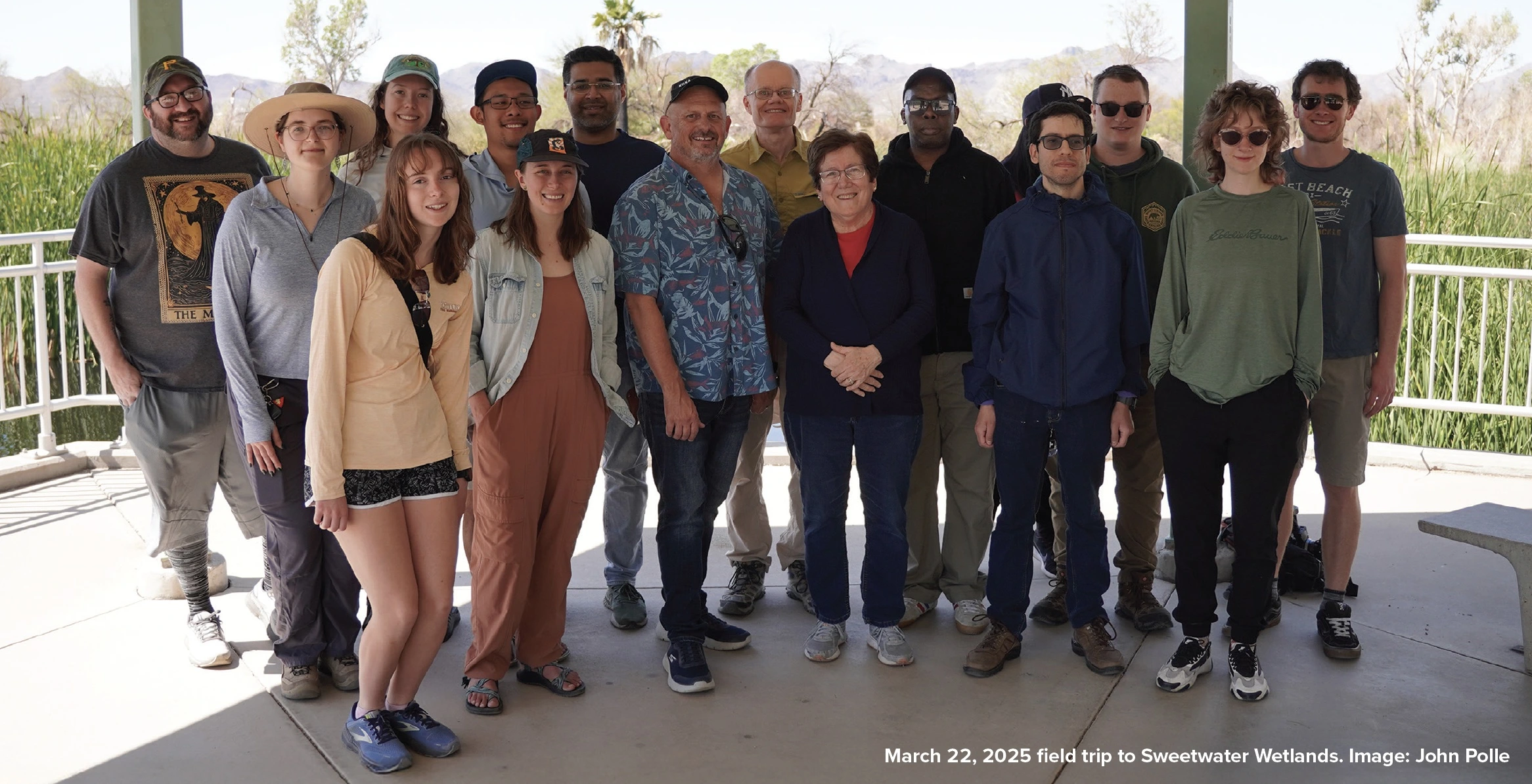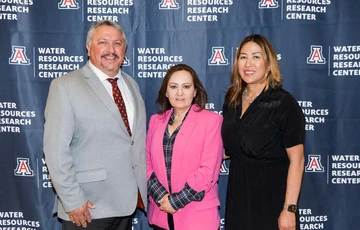
Each Spring, I typically reflect separately upon take-aways from teaching the graduate seminar, Water Policy in Arizona and Semi-arid Regions, and from the WRRC’s Annual Conference. This year, I am combining them because our 2025 Annual Conference, Shared Borders, Shared Waters: Working Together in Times of Scarcity, was scheduled immediately after the semester ended. Frankly, the whirlwind of activities has left little time to reflect.

From left: Ramon Macias III, Principal Engineer, International Boundary and Water Commission – US Section, Adriana Reséndez, Commissioner, International Boundary and Water Commission – Mexican Section, Meena Westford, Director of Imported Water, San Diego County Water Authority.
Image: Jay Shodja Corella
Each Spring, a clear take-away from my class is one of optimism, and this year is no different. The 12 graduate students were highly engaged throughout the semester. Guest speakers regularly commented on their insightful questions. Throughout the semester, the students revealed deep interest in understanding complex matters associated with water policy as reflected in class readings, lectures, and individual assignments, including their policy-oriented research paper.
Likewise, each year, usually in the Spring, the WRRC convenes its Annual Conference. Our May 20-21, 2025, conference focused on sharing water across borders, broadly construed. With the help of a large and diverse advisory committee, we designed a quick-moving program. The agenda was packed with excellent speakers, including Arizona Governor Hobbs, Tribal Leaders, the Commissioner of the International Boundary and Water Commission - Mexican Section, along with many others who offered informative assessments of how we have worked together across borders and must continue to work collaboratively to address our region’s water challenges. Although speakers did not shy away from speaking frankly about the challenges, I sensed a generally positive outlook on tackling the challenges, along with a commitment to working together.
That we face major issues cannot be denied. While there are differences in exactly how to define them, I will place them in two buckets: surface water issues and groundwater issues. Simply put, both resources are declining. The Colorado River, which has provided over a third of Arizona’s water supplies, is flowing on average at levels much below those of the last century. Groundwater continues to be pumped across much of Arizona at rates that greatly exceed recharge rates. Lest anyone remain unaware, I will note that the shrinking annual flows of Colorado River water, along with the depletion of much of the surface storage at Lakes Powell and Mead (the river system’s savings accounts), make for highly concerning projections of water availability for deliveries through the Central Arizona Project. Indeed, serious concerns about water deliveries and hydropower exist basin wide. The regular 24-month reports of the Bureau of Reclamation do not paint a pretty picture.
In many parts of Arizona, the groundwater situation is concerning. Groundwater depletion information presented by the Arizona Department of Water Resources (ADWR) to the Governor’s Water Policy Council in 2023 likewise does not paint a pretty picture, and the situation is not improving. Groundwater in storage is being depleted. In many parts of Arizona, where surface water supplies are not available and aquifers receive very limited recharge, the groundwater savings account is being compromised. Depending on the rate of withdrawals, the account will be depleted at some point in the future – if actions are not taken.
The good news is that, on each front, actions are being contemplated. Negotiations continue on the new operating guidelines for the Colorado River. These new guidelines must be in place by the end of 2026, which is not very far off. The conference’s closing keynote speaker, ADWR Director Tom Buschatzke, spoke more optimistically than I expected. Governor Hobbs spoke about the potential for agreement on a framework for regulating groundwater use in rural Arizona. Action is needed. Yet, with the Legislature’s regular session end date approaching and news reports indicating that there are still differences to be resolved, time is short.
Some actions designed to address projected water supply-demand imbalances have been taken or are underway. The Arizona Department of Environmental Quality has adopted rules for Advanced Water Purification (AWP). As discussed in the April 11, 2025, WRRC Water Webinar, cities in Arizona are moving forward with AWP plans. Arizona’s Water Infrastructure Planning Authority has issued millions of dollars in conservation assistance grants and is implementing a strategy for long-term water augmentation. There are many questions, however, about the costs and timing of long-term augmentation projects, which are not yet defined. In addition, the speakers from the Mexican and US sections of the International Boundary and Water Commission described their work on water supply, water treatment, and groundwater assessments. Because space precludes me from listing here all the important work and insights we heard at the conference, I urge those who were unable to attend to consult the agenda, which now includes links to recordings of presentations and panel discussions.
Opening keynote speaker Professor Aaron Wolf of Oregon State University underscored the potential for agreement among people with diverging perspectives. His workshop about listening and interacting provided tools for finding common ground. Later, conference panelist Glenn Williamson, CEO of the Canada Arizona Business Council, noted the importance of timeliness. He warned that some options may be foreclosed if it takes us too long to come to agreement on pathways forward.
With temperatures rising as we approach summer, I find myself with countervailing feelings. The conference discussions left me feeling generally positive due to the can-do attitudes and reports of partnerships and collaborations of so many speakers. Interacting with the students in my class, along with many other early-to-mid-career professionals, leaves me encouraged that we have a great pipeline of people to tackle the issues. On the other hand, serious water challenges require action, and we appear to be having difficulty agreeing on how to tackle them. I hope we can resolve our differences and develop pathways forward, pathways that avoid protracted legal battles. Court proceedings, which are often lengthy and expensive, may decide an issue but do not produce water. Let’s work together to figure things out!

